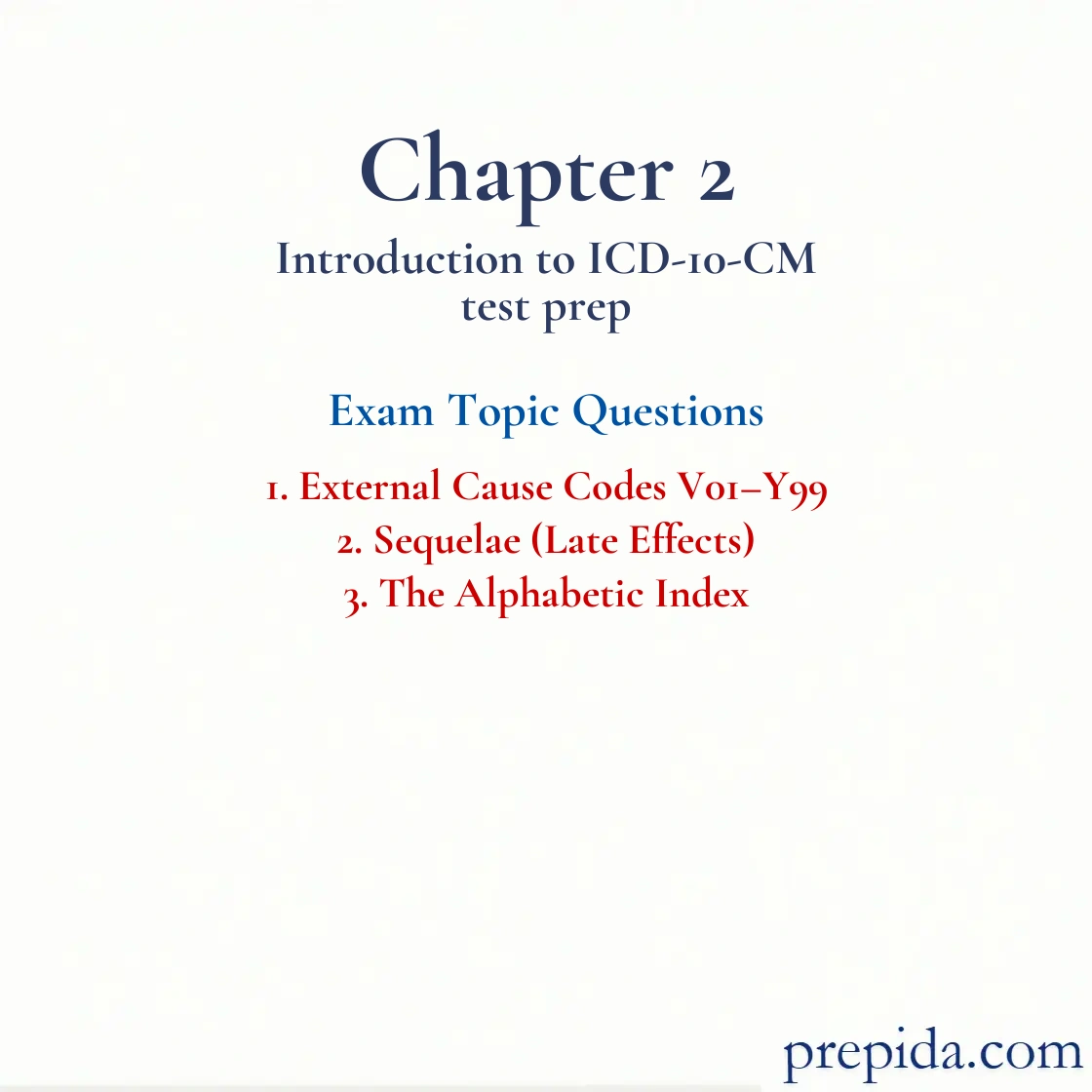
Which of the following external cause codes is used to report the status of a patient who was injured while participating in a volunteer activity?
- Y99.1
- Y99.2
- Y99.3
- Y99.4
External cause code Y99.2 would be used to show that the patient was participating in a volunteer activity when the accident/injury occurred. Y99.2: External cause index>status>volunteer activity.
E Codes: Codes that report how and/or where an injury or poisoning happened.
An external cause code is used when a patient has:
- an adverse effect.
- an injury.
- been poisoned.
- All of these
External cause codes are used when an individual has an injury, poisoning, or adverse effect.
External Cause: An event, outside the body, that causes injury, poisoning, or an adverse reaction.
External cause codes may never be reported as:
- a principal or first-listed diagnosis.
- the only diagnosis code.
- the principal diagnosis or be the only diagnosis code.
- None of these
External cause codes must be a secondary diagnosis. They can never be the first-listed/primary diagnosis.
Principal Diagnosis: The condition that is the primary, or main, reason for the encounter.
What is the correct external cause code for a patient who fell out of a stationary wheelchair, initial encounter?
- W05.0XXA
- W05.1XXA
- W05.2XXA
- W07.XXXA
W05.0XXA is the correct external cause code for a patient who fell out of his or her stationary wheelchair, initial encounter. W05.0XXA: External cause index>fall>from>wheelchair, non-moving>initial encounter.
External Cause: An event, outside the body, that causes injury, poisoning, or an adverse reaction.
Mark broke his left arm after he fell into an empty swimming pool, initial encounter. What is the correct external cause code that should be assigned?
- W17.2XXA
- W17.3XXA
- W17.2XXD
- W17.2XXD.
W17.3XXA is the external cause code for Mark's fall into an empty swimming pool, initial encounter. W17.3XXA: External cause index>fall>into>swimming pool>empty>initial encounter.
External Cause: An event, outside the body, that causes injury, poisoning, or an adverse reaction.
External cause codes explain:
- how a patient became injured.
- where an injury occurred.
- what the physician did for the patient.
- how a patient was injured and where an injury occurred.
External cause codes explain how a patient became injured and the place the patient was when he/she was injured.
E Codes: Codes that report how and/or where an injury or poisoning happened.
A cause-and-effect relationship between an original condition, illness, or injury and an additional problem caused by the original condition is known as a(n):
- adverse effect.
- injury.
- late effect.
- manifestation.
A late effect is a cause-and-effect relationship between an original condition, illness, or injury and an additional problem caused by the original condition.
Late Effect: Cause-and-effect relationship between an original condition, illness, or injury and an additional problem caused by the existence of that original condition. Time is not a requirement for a diagnosis as a late effect because the additional concern may be present at any time.
When coding a late effect from a pregnancy-related condition, how long is the postpartum period?
- Immediately after delivery
- 2 weeks
- 4 weeks
- 6 weeks
Postpartum is within 6 weeks after delivery.
Late Effect: Cause-and-effect relationship between an original condition, illness, or injury and an additional problem caused by the existence of that original condition. Time is not a requirement for a diagnosis as a late effect because the additional concern may be present at any time.
Which of the following codes is used to report a patient who has dysphasia following a nontraumatic intracerebral hemorrhage?
- I69.121
- I69.321
- I69.821
- I69.991
I69.121 is used to report a patient who has dysphasia following a nontraumatic intracerebral hemorrhage. I69.121: Index>sequelae>disease>hemorrhage>intracerebral>dysphasia.
Cerebrovascular Accident (CVA): Rupture of a blood vessel in the brain; also known as stroke.
What seventh character is used to identify a condition as a sequela?
- A
- C
- S
- X
The seventh character S is used to report a sequela.
Condition: A health-related situation.
George's broken foot did not heal properly. Today's encounter is coded as a(n):
- current condition.
- injury.
- late effect.
- adverse reaction.
The fracture did not heal properly, which is a late effect.
Late Effect: Cause-and-effect relationship between an original condition, illness, or injury and an additional problem caused by the existence of that original condition. Time is not a requirement for a diagnosis as a late effect because the additional concern may be present at any time.
An ICD-10-CM diagnosis code can have up to how many characters?
- 5
- 6
- 7
- 8
ICD-10-CM codes can include up to 7 characters.
ICD-10-CM: The acronym for International Classification of Diseases, Tenth Revision, Clinical Modification.
In the diagnosis "right fractured tibia," what is the main term a coder should look up in the Alphabetic Index?
- Broken
- Fracture
- Right
- Tibia
The main term is the condition, injury, disease, or illness.
Fracture: Broken cartilage or bone.